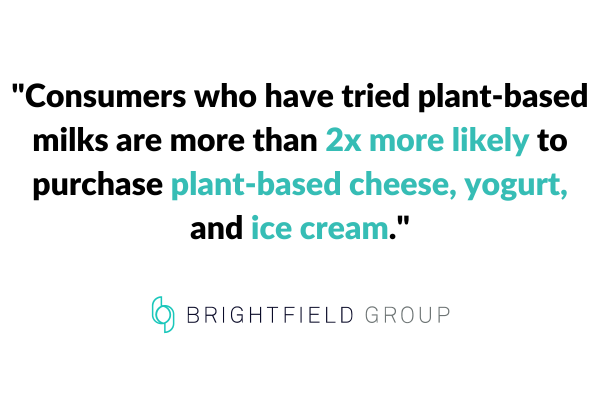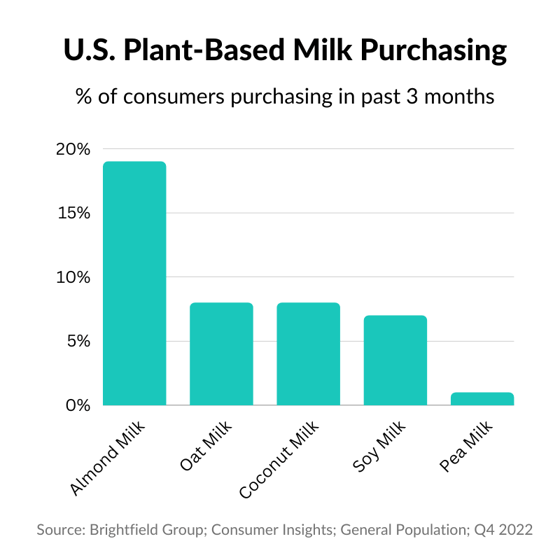In recent years, the popularity of plant-based alternatives has skyrocketed, and nowhere is this more evident than with plant-based milks. As more people embrace alternative dietary choices, the market for milk has expanded to include options for plant based consumers. Various plant based milks have become staples on grocery store shelves and in coffee shops worldwide, further extending the target market for plant based milk well beyond vegan and vegetarian consumers.
In this blog post, we will delve into dairy industry trends and explore how consumer’ plant-based choices are paving the way for the rising popularity of other alternative dairy products.
What are the latest trends in plant-based products?
New alternative food products are constantly evolving, driven by plant based consumer trends towards sustainable, healthy, and tasty alternatives to traditional animal-based foods. Plant-based meat substitutes experienced their own surge in popularity, with advancements in food science enabling companies to create products that closely mimic the taste, texture, and even "bleeding" effect of animal-based meats.
Similarly, the demand for plant-based options in the snack foods and convenience item space has increased in recent years – think chips, cookies, and protein bars. The growing market for ready-to-eat plant-based meals provides convenient and nutritious options for individuals seeking quick and healthy plant-based options.
While the popularity of these plant-based food items is undeniable, nothing compares to the popularity of plant-based milks. Plant-based milk, derived from sources such as soy, almonds, oats, and rice, has shaken up dairy trends, revolutionizing what we consider “milk.” Brightfield Group consumer insights show the most popular variety is almond milk, with 19% of U.S. consumers purchasing the common dairy alternative. Oat and coconut milk come in at second and third place, each seeing 8% of consumers purchasing.
Consumers are increasingly drawn to these alternatives for a variety of reasons, including health concerns, environmental consciousness, and ethical considerations. Some people also just enjoy the taste!
Why are people choosing plant-based dairy?
One of the key drivers of the popularity of plant-based milks is the growing awareness of lactose intolerance and milk allergies. Many people find traditional dairy products difficult to digest, leading them to seek alternatives that are gentler on their stomachs. Plant-based milks offer a viable solution, providing a creamy and flavorful experience without the lactose or allergenic proteins found in cow's milk.
The environmental impact of traditional dairy farming practices is also a significant factor behind the rise of plant-based milks. Consumers are becoming more conscious of the carbon footprint associated with animal agriculture and are actively seeking sustainable alternatives. Plant-based milks require fewer resources, including water and land, and generate fewer greenhouse gas emissions compared to their dairy counterparts. This alignment with environmental concerns has contributed to the popularity of plant-based milks as a more eco-friendly choice.
Moreover, the versatility and taste of plant-based milks have improved significantly in recent years, attracting even more consumers. Manufacturers have invested in research and development to enhance the texture and flavor profiles of plant-based milks, making them more comparable to traditional dairy milk.
As a result, plant-based milks are now used not only as standalone beverages but also as key ingredients in recipes, such as smoothies, baked goods, and savory dishes. Plant-based milks are also becoming more accessible the more popular they get – 49% of consumers surveyed purchased their beverages at traditional grocery stores.
Key consumer message for dairy: It’s not all about being “plant-based,” it’s about consumers having options and making their own choices.
The Opportunity for Plant-Based Dairy
The surge in popularity of plant-based milks has also influenced the broader plant-based product market. As consumers become more comfortable with plant-based milks, they are more likely to explore other dairy alternatives.

Brightfield Group’s consumer insights show that consumers who have tried plant-based milks are more than 2x more likely to purchase plant-based cheese, yogurt, and ice cream. Interestingly though, crossover purchases with their full dairy counterparts is stronger with non-milk dairy replacements, especially plant-based ice cream, suggesting either trials of these products or consumers intentional decision to flip flop between the two.
This trend has sparked a wave of innovation, with companies creating delicious and sustainable alternatives to cater to a growing demand for plant-based dairy products.These products provide consumers with an opportunity to experience the flavors and textures they once associated exclusively with traditional dairy, but with the added benefits of sustainability and animal welfare.
The key takeaway: Plant-based consumer demographics have expanded to include individuals who enjoy both animal and plant-based options.
Who Drinks Plant Based Milk?
Millennials and Gen Z represent a significant portion of plant-based milk consumers, with 51% of them between the ages of 24 and 49. These younger generations prioritize health and wellness, actively seeking plant-based alternatives as part of their dietary choices. They also tend to be more affluent – 71% of regular plant-based milk drinkers earn over $50K annually. Brightfield Group data also suggests that plant-based milk drinkers lean more female (51%) than male.
Though it may seem like the whole world is crazy for plant-based milks, there are still plenty of people who are not yet willing to dabble in plant-based dairy. Brightfield Group data shows that 26% of consumers are still sitting on the fence when it comes to purchasing plant-based dairy. This can be attributed to any number of factors: some consumers may simply be risk-averse, while some may be less likely to splurge on unfamiliar products in a rocky economy.
Plant-based milks have emerged as a dominant force in the realm of plant-based products, driven by health considerations, environmental consciousness, and improved taste. Their popularity has paved the way for a broader shift towards plant-based dairy alternatives. As consumers increasingly embrace plant-based milks, the market for plant-based products continues to expand, providing exciting opportunities for businesses and entrepreneurs to cater to the evolving demands of conscious consumers.
Published: 6/2/2023






